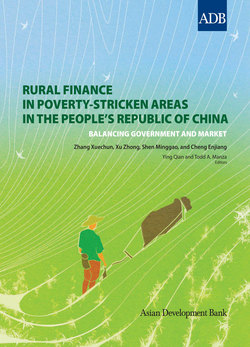Читать книгу Rural Finance in Poverty-Stricken Areas in the People's Republic of China - Xuechun Zhang - Страница 38
На сайте Литреса книга снята с продажи.
Market Liberalization and Rural Financial Development
ОглавлениеLiberalization of the PRC’s rural financial market entered a new stage in 2005, and the most notable reforms are the pilots of microfinance companies and new types of financial institutions. Since the second half of 2005, the PBC has piloted microfinance companies in five provinces and regions, and in May 2008, the pilot was expanded nationwide (including Guizhou, Inner Mongolia Autonomous Region, Shaanxi, Shanxi, and Sichuan). Presently, nearly 500 microfinance companies have been established. In addition, the China Banking Regulatory Commission relaxed market entry requirements for rural financial institutions and, at the end of 2006, piloted the liberalization of rural financial markets in Gansu, Hubei, Inner Mongolia Autonomous Region, Jilin, Qinghai, and Sichuan. In addition to microcredit institutions that provide lending without taking deposits, other new types of financial institutions include village banks, loan companies, and mutual financial organizations (also called mutual fund associations).
The PSBC is well positioned to rely on its current network of outlets to improve financial services with retail and intermediary businesses in both urban and rural areas
Market opening also has provided a base for the legalization of informal credit
A great number of farmers have gained control over their agricultural production, supply, and sales through the family contract responsibility system, and the liberalization of the rural financial market allows farmers to legally obtain credit. Production, supply, sales, and credit can work together to help farmers gain a competitive edge in the growing market economy.
Market opening also has provided a base for the legalization of informal credit. Some qualified informal creditors could become legal rural financial institutions through registration. Such institutions, as well as loan companies with a 100% capital adequacy ratio, RCCs with relatively low capital adequacy ratios, and other commercial banks, including the ABC, will present a complete spectrum of rural financial institutions, and such diversity of institutions can better meet diverse financial demands. In addition, private capital (including foreign capital) is now, for the first time, allowed to purchase a stake in and control newly established financial institutions. Pilot provinces have experienced an increase in mutual financial organizations self-managed by farmers, private microfinance companies, and village banks representing partnerships between financial institutions and private investors.
